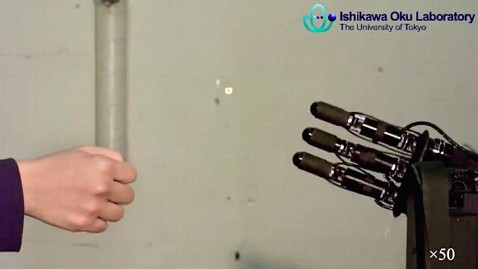Japanese Robot Never Loses Rock-Paper-Scissors

(Image Credit: Ishikawa Oku Lab via YouTube)
In the ongoing battle between man and robot, the robot seems to have the upper hand when it comes to the game rock-paper-scissors.
Researchers at the University of Tokyo have developed what amounts to a mechanical hand that is guaranteed to win the age-old game 100 percent of the time.
Professor Masatoshi Ishikawa says the robot utilizes something called the human-machine cooperation system, which relies on high-speed vision to stay a step ahead of the opponent. "This has nothing to do with prediction," Ishikawa said. "The robot is playing the exact same game, but it can move 33 times faster than humans. There's no way to win."
Ishikawa says the robot can process 1,000 frames per second, while the human eye can only process 30, at most. Put simply, the machine has the capability to read the opponent's hand faster than the human eye and, as a result, respond at lightning speed.
The rock-paper-scissors hand is the latest in a string of robots Ishikawa's lab has developed to trump man's abilities.
The dribbling robot consists of a mechanical finger that can dribble the ball faster than the human eye can see.
The tweezer robot can catch tiny objects in the air with tweezers, 100 percent of the time.
A few years ago, Ishikawa built a batting robot that hit any ball within the strike zone, every single time. "We put the robot up against a professional baseball player, and it embarrassed him," Ishikawa said. "We felt so bad."
The rock-paper-scissors machine was built at the request of a Japanese TV station that wanted a robot that was "easier to understand," Ishikawa said. It was developed more than a year ago, but he posted video of it on YouTube earlier this week. It went viral, amassing nearly 800,000 hits in a few days.
"I had no idea it would be such a hit," he said. "Most of the feedback I've gotten has been from the U.S."
While a game-playing mechanical hand and a batting robot might not seem practical, Ishikawa says, the software used in his machines could play an important role in the future, as Japan's workforce shrinks, and the population ages rapidly.
He envisions his robots on assembly lines of manufacturers, in hospitals, assisting with surgeries. He says they can even be used in science labs to analyze microscopic slides that are often hard to see with the human eye.